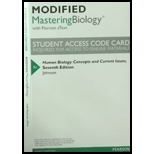
MasteringBiology With eText - Access
7th Edition
ISBN: 9780321911940
Author: Johnson
Publisher: PEARSON
expand_more
expand_more
format_list_bulleted
Concept explainers
Textbook Question
Chapter 3, Problem 1AWK
Imagine that you are shown two cells under the microscope. One is small, has lots of mitochondria, and contains numerous glycogen granules. The other is somewhat larger and has only a few mitochondria and no glycogen granules. Which cell do you think is more
Expert Solution & Answer
Want to see the full answer?
Check out a sample textbook solution
Students have asked these similar questions
In the image below of a region of the mitochondria, which region would have the highest concentration of hydrogen ions?
Choose one from the following:
(a) A
(b) B
Imagine that you are shown a tissue sample under the microscope. One cell type in the tissue lacks a nucleus and is red in color. A second type is white, has a nucleus, and contains numerous vesicles. Are both cell types of the same origin? Which cell is metabolically active?
Which type of cells would have more mitochondria & why?
Chapter 3 Solutions
MasteringBiology With eText - Access
Ch. 3 -
1. What is your opinion on this controversy? What...Ch. 3 - Prob. 2QCCh. 3 - Prob. 1CRCh. 3 - Prob. 2CRCh. 3 - Describe how phospholipids are oriented in the...Ch. 3 - Define passive transport and name the three...Ch. 3 - Compare and contrast endocytosis and exocytosis.Ch. 3 - Describe the activity of the sodium-potassium pump...Ch. 3 - Prob. 7CRCh. 3 - Prob. 8CR
Ch. 3 -
9. What are the four stages of ATP production...Ch. 3 -
10. Describe what happens to a cell’s ability to...Ch. 3 -
1. Which of the following adaptations would...Ch. 3 - Which of the following would be most likely to...Ch. 3 - Prob. 3TYCh. 3 - Red blood cells placed in distilled water will: a....Ch. 3 - Which organelles are most active during vigorous...Ch. 3 - Phagocytic white blood cells engulf and digest...Ch. 3 - Prob. 7TYCh. 3 -
8. Which organelles would be active in liver...Ch. 3 - Prob. 9TYCh. 3 -
10. Which of the following is/are the most...Ch. 3 - Prob. 11TYCh. 3 - Prob. 12TYCh. 3 -
13. In which stage of cell respiration does...Ch. 3 - Which of the following is/are recycled during...Ch. 3 - Most of the ATP produced during cell respiration...Ch. 3 - Imagine that you are shown two cells under the...Ch. 3 - The sodium-potassium pump is a large protein...Ch. 3 - Mitochondria resemble a bacterial cell in a number...Ch. 3 - Prob. 4AWKCh. 3 - Recently, a young man from Derby in the United...Ch. 3 - You have been selected to serve on a jury for a...
Knowledge Booster
Learn more about
Need a deep-dive on the concept behind this application? Look no further. Learn more about this topic, biology and related others by exploring similar questions and additional content below.Similar questions
- What is the function of the mitochondria? What is the relationship between ATP and ADP? Why is ATP so important in biological systems?arrow_forwardIf samples of muscle tissue were taken from the legs of a world-class marathon runner and a sedentary individual, which would you expect to have a higher density of mitochondria? Why?arrow_forwardWhat type of cell gains more ATP from aerobic cellular respiration- prokaryotes or eukaryotes? Explain this differencearrow_forward
- Why should it make sense that a mitochondrion(a cellular organelle) is larger than a phospholipid molecule?arrow_forwardWhy is a mitochondria like a battery?arrow_forwardWhich of the following explains why a cell's size is limited? a The cell membrane increases too fast for the cytoplasm to keep up with its reactions. b The cell membrane becomes rigid. c The cell membrane cannot supply enough substances to support organelles in the center. d The cell membrane is too large to allow for transport.arrow_forward
- Cyanide binds with at least one of the molecules involved in the production of ATP. Following exposure to cyanide, the cyanide would accumulate which part of the cell? 1. Endoplasmic reticulum 2. Lysosomes 3. Mitochondria 4. Ribosomesarrow_forwardWhat type of cells in your body do you think have the most mitochondria?why?arrow_forwardImagine that you develop a procedure to measure the pH of in the matrix and the intermembrane space of a mitochondrion. What pattern of pH would you see? The pH in the intermembrane space will contain more H+ and have a lower pH compared to the matrix. The pH in the intermembrane space will contain more H+ and have a higher pH compared to the matrix. The pH within the matrix will contain more H+ and have a lower pH compared to the intermembrane space. The pH within the matrix will contain more H+ and have a higher pH compared to the intermembrane space.arrow_forward
- Using the concepts of endo- and exo-cytosis explain the origin of the mitochondria. Include a drawingarrow_forwardcurved lines inside the mitochondria are known as what?arrow_forwardHow do mitochondria and chloroplasts differ? Why is it unnecessary for our cells to have a cell wall? What might happen if the lysosomes inside a cell stopped working properly?arrow_forward
arrow_back_ios
SEE MORE QUESTIONS
arrow_forward_ios
Recommended textbooks for you
 Human Physiology: From Cells to Systems (MindTap ...BiologyISBN:9781285866932Author:Lauralee SherwoodPublisher:Cengage Learning
Human Physiology: From Cells to Systems (MindTap ...BiologyISBN:9781285866932Author:Lauralee SherwoodPublisher:Cengage Learning Human Biology (MindTap Course List)BiologyISBN:9781305112100Author:Cecie Starr, Beverly McMillanPublisher:Cengage Learning
Human Biology (MindTap Course List)BiologyISBN:9781305112100Author:Cecie Starr, Beverly McMillanPublisher:Cengage Learning Biology (MindTap Course List)BiologyISBN:9781337392938Author:Eldra Solomon, Charles Martin, Diana W. Martin, Linda R. BergPublisher:Cengage Learning
Biology (MindTap Course List)BiologyISBN:9781337392938Author:Eldra Solomon, Charles Martin, Diana W. Martin, Linda R. BergPublisher:Cengage Learning


Human Physiology: From Cells to Systems (MindTap ...
Biology
ISBN:9781285866932
Author:Lauralee Sherwood
Publisher:Cengage Learning

Human Biology (MindTap Course List)
Biology
ISBN:9781305112100
Author:Cecie Starr, Beverly McMillan
Publisher:Cengage Learning

Biology (MindTap Course List)
Biology
ISBN:9781337392938
Author:Eldra Solomon, Charles Martin, Diana W. Martin, Linda R. Berg
Publisher:Cengage Learning
Mitochondrial mutations; Author: Useful Genetics;https://www.youtube.com/watch?v=GvgXe-3RJeU;License: CC-BY